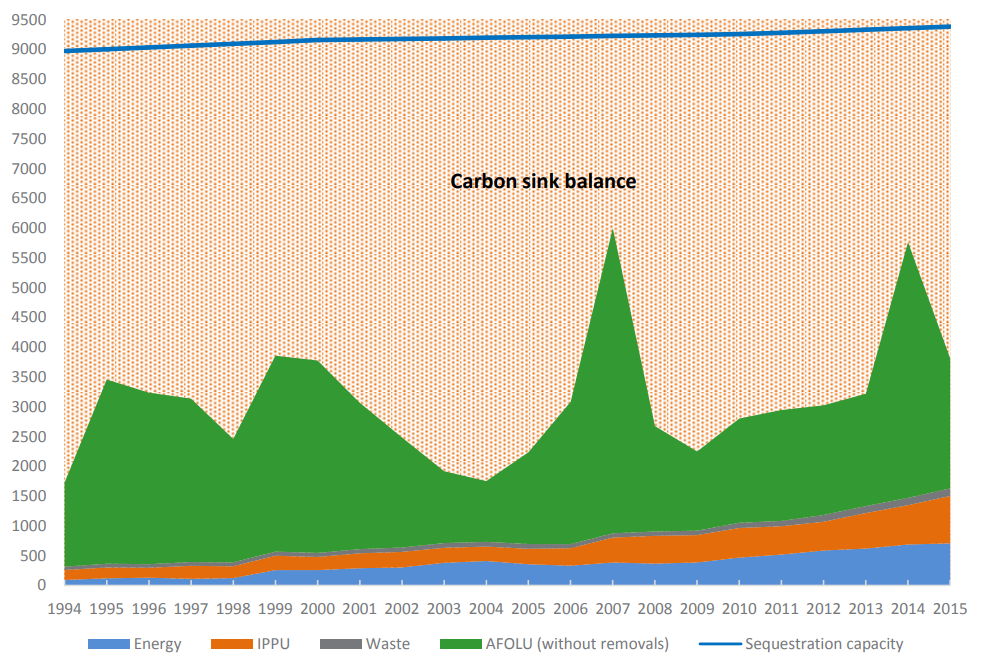 Monastery in a cliffside in Bhutan.
Monastery in a cliffside in Bhutan.
Nestled within the Eastern Himalayas, Bhutan is often referred to as the ‘Land of the Thunder Dragon’. This evocative name, steeped in mythology and reverence, perfectly captures the spirit of a nation where tradition, nature and mindfulness converge harmoniously.
Bhutan is the world’s first carbon-negative country; its vast forests absorb more carbon dioxide (CO2) than the country emits from all activities. This accomplishment stems from Bhutan’s holistic approach to development. Its Gross National Happiness (GNH) index goes beyond traditional economic measurements, placing importance on the spiritual, physical, and social well-being of its citizens alongside cultural and environmental conservation. The country’s constitution mandates that at least 60% of its land remains forested for generations to come, naturally enhancing carbon sequestration.
The Kingdom is enveloped by abundant forests, which in fact stretch across 72.3% of its land. These areas represent not just ecological and biodiversity reserves but also massive carbon assets, making its forests a significant “carbon bank.” Further, the country’s rivers generate low-carbon hydroelectricity for neighbouring countries, thereby reducing regional emissions. In 2021, Bhutan generated nearly 11,000 GWh of electricity and exported over 80% of it. Bhutan’s Nationally Determined Contributions (NDCs) note the possibility of offsetting 22.4 million tonnes of CO2 emissions in the region by 2025 through the export of hydroelectricity.
"The Kingdom is enveloped by abundant forests, which stretch across 72.3% of its land. These areas represent not just ecological and biodiversity reserves but also massive carbon assets, making its forests a significant 'carbon bank.'"

Emerging technologies to quantify carbon assets
While deeply rooted in tradition and natural heritage, Bhutan is embracing a global wave of technology and innovation to create more accurate, efficient, secure, and transparent carbon markets. Article 6 of the Paris Agreement allows countries to voluntarily cooperate with each other to implement their NDCs. Bhutan could monetize its emission reductions from various sectors such as renewable energy and forestry, channeling climate finance to the country.
In July, the FAB23 "Designing Resilient Futures" international conference in Thimphu brought together the World Bank’s Climate Warehouse, Druk Holdings Investment Ltd. (DHI), the Bhutan Ministry of Environment and AirCarbon Exchange. They discussed the crucial role of emerging technologies in assessing and managing the country’s carbon assets. This dialogue accentuated the synergy between a resilient future, technology, and natural capital accounting in crafting a future-ready and environmentally conscious Kingdom.
Technological advancements in Measurement, Reporting and Verification (MRV) systems – the process to measure GHG emissions reductions – enable carbon assets to be assessed with unprecedented accuracy and speed. Information from satellites, drones, and on-the-ground sensors and meters create a comprehensive picture of the forest landscape and hydropower sector:
- Satellite remote sensing scans vast tracts of land, conducts temporal monitoring changes in forest cover over time, and assesses vegetation types and stages of forest growth.
- Drones (UAVs) capture detailed images of forest canopy and create three-dimensional maps of forests to estimate volume of biomass, and, by extension, the carbon stored.
- Ground-based sensors, smart-meters and Internet-of-Things provide real-time data, tracking parameters like tree growth rates, soil moisture, temperature and other variables related to forest and reservoir health, resilience, energy generation and water quality in dam sites.
Enhanced data allow for more precise carbon storage or reduction estimates. Machine learning and artificial intelligence help analyze large data sets to identify patterns and trends. These advancements will enable the country to fully utilize its forests as both carbon sinks and renewable energy sources while accurately tracking carbon assets.
"While deeply rooted in tradition and natural heritage, Bhutan is embracing a global wave of technology and innovation to create more accurate, efficient, secure, and transparent carbon markets."
Infrastructure to track and trade carbon assets
Additional infrastructure is needed to support tracking, issuance, and trade of carbon assets. Bhutan and other countries can participate in domestic and international carbon markets with infrastructure including:
- National GHG inventory – to track a country’s carbon emissions and removals, and its global impact, and to monitor its emission sources and types. The inventory categorizes emissions and removal by sector, and updates regularly with new data.
- National carbon registry – to help countries track and record carbon credits and offsets, manage their carbon footprint, monitor compliance with the Paris Agreement and domestic climate policies, and facilitate the trading of carbon credits or allowances.
- Tokenization mechanism – to create digital representations of carbon credits that can be stored and traded through a credentialed wallet system using distributed ledger technology (DLT). The objective of this mechanism revolves around improving the efficiency, transparency, and accessibility of carbon markets. It also provides an opportunity to make carbon asset management more tangible and participatory for Bhutan’s citizens by potentially integrating it with the national digital identity (NDI), which can streamline services and boost security.
- Integration of the national registry with the global metadata layer Climate Action Data Trust (CAD Trust) – to connect with registries across the world, and aggregate and harmonize carbon project and units data with the objective to enhance transparency and trust in international carbon markets.
The World Bank is currently engaged in all of the above components, together with the Partnership for Market Implementation (PMI) and Digital for Climate (D4C), to support developing countries to harness the potential of carbon markets and facilitate access to climate finance.
"Infrastructure is needed to support the tracking, issuance, and trading of carbon assets."
Towards a mindful and equitable carbon strategy in Bhutan
Bhutan champions sustainable development, levering its carbon-neutral status to innovate in carbon markets and prioritize eco-friendly technological advancements:
- Mindful approach to technology and innovation – Bhutan's commitment to the GNH index instead of just GDP exemplifies its holistic vision of evaluating innovation’s impact on its citizens’ well-being, cultural preservation, and environmental sustainability.
- Leveraging carbon assets – Bhutan has turned commitment to environmental conservation into a valuable asset. Through strategic management of its primary carbon sinks, Bhutan not only emphasizes its ecological responsibilities but also establishes itself as a forerunner in the international carbon trading arena.
- Integrating sustainable technology – From harnessing clean energy sources like hydropower to promoting eco-friendly agricultural practices, technology is seen as a tool to enhance sustainable practices, not replace them.
In the Land of the Thunder Dragon, where clouds embrace dense forests and traditions intertwine with the future, Bhutan's aspirations soar higher than ever, harnessing the strength of its carbon assets to be a leader in the battle against climate change.




Join the Conversation